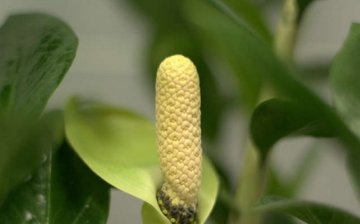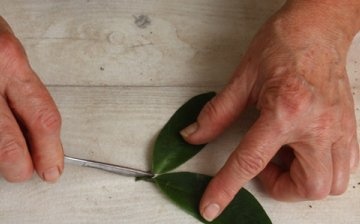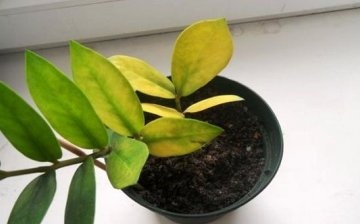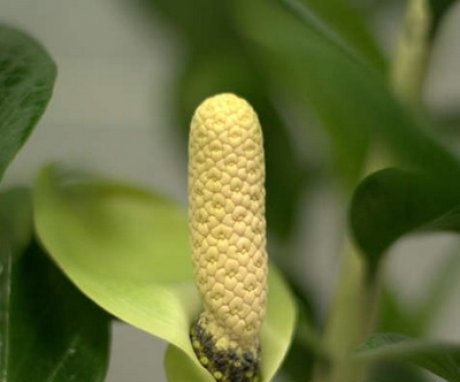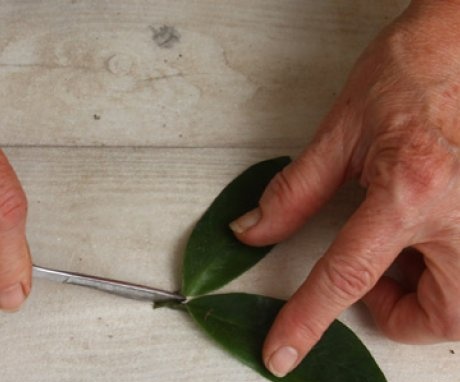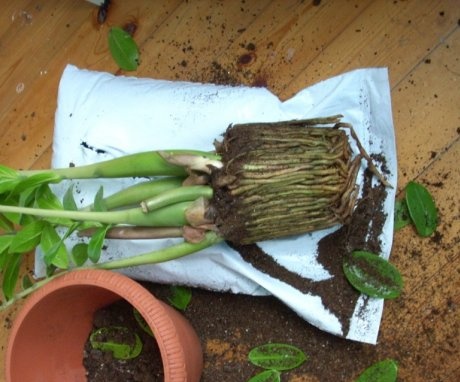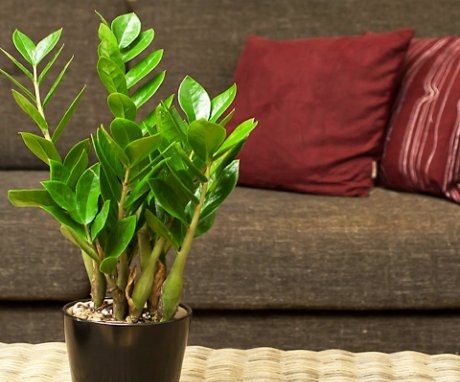Zamioculcas - a beautiful and unpretentious indoor flower
Many tropical plants have won the hearts of indoor floriculture lovers. Zamioculcas from the Aroid family attracts with its unusual appearance, its dark green shiny leaves adorn not only living quarters, but also offices and banks. But its leaves and tubers are poisonous, so you need to be careful in contact with them.
Content:
- Indoor plant description
- Flower reproduction methods
- Transplant, conditions for growing zamiokulkas
- Exotic plant care rules
- Diseases, pests of the flower, the fight against them
Indoor plant description
The only one of its kind, zamiokulkas consists of fleshy green petioles with feathery leaves on the sides. They emerge immediately from the base of the plant, which resembles a rosette. Under the ground there is a large tuber of a flower that has the function of accumulating moisture.
A tropical African blooms only after a few years, forming at the very bottom an inflorescence similar to an ear of corn with small white flowers, surrounded by a green veil.
The flower grows slowly, even the dark green leaves are renewed every few years.
When discarding old foliage, the base of the plant is sometimes exposed. An adult zamiokulkas reaches a meter in height, therefore it is suitable for spacious rooms.
Flower reproduction methods
An exotic plant is propagated by several methods:
- The cut leaf is left for some time to dry out the cut site. After a few hours, the lower part of the leaf is treated with activated carbon or Kornevin. After that, it is buried in the soil of peat and sand, and the container is covered with film or glass. It will be necessary to air the planted leaf, and in a month the roots should appear. But the faster the leaf takes root in the water.
- The most convenient way is reproduction cuttings... To obtain material for planting, it is enough to cut off a branch with middle-aged leaves. Then it is divided into parts of three sheets each. After several hours, a windy layer should form at the cut sites, which is then sprinkled with powder from charcoal or activated carbon. For better rooting, containers with universal light soil, where prepared cuttings are planted, are placed under glass containers or film caps. Two to three days after planting, watering is carried out through a spray bottle. As soon as the roots appear, the cuttings are opened. Leaves should appear on them in six months.
- During transplanting, the plant can be divided into separate parts, so that each has a growth bud, which contributes to better rooting. Before placing the plant in the soil, parts of it are dried. For growth and development, zamioculcas needs a light breathable soil with the addition of vermiculite.
The use of any method of propagation of an indoor flower is simple and safe for the plant, and gives a positive result.
Transplant, conditions for growing zamiokulkas
As the zamiokulkas grows, transplanted, doing this when the tubers become cramped in the container.Young plants - at least once every two years, and adults - at five years. For this, a large pot is selected, preferably an earthen one. Drainage is laid at the bottom of the flowerpot for a quarter of its volume, for which expanded clay is suitable.
The soil for a flower requires a universal one, in which there will be enough peat and sand.
It must pass air and water well. The transplant is carried out by the transshipment method, trying not to damage the rhizome. The underground tuber is not placed too deep in the pot.
For zamioculcas, a place in the room is chosen so that there is enough lighting, although diffused light will do. The ideal temperature for a native of the African tropics will be above twenty in the summer, and in winter he is comfortable at plus eighteen degrees. Although the flower is not afraid of sudden changes in temperature, too low will be fatal for it.
Requiring no special conditions for growth, zamioculcas will delight with bright greenery only in good lighting and optimal temperature.
Exotic plant care rules
One of the most unpretentious plants, zamioculcas, still wants some rules for caring for it to be followed:
- TO watering special requirements: less moisture is better than excess moisture. But you do not need to forget about an important condition for the life of an indoor flower. If there is no watering, then the plant can shed all the leaves. But with a live tuber, it will revive again after spraying or watering. Watering is necessary after the top layer of soil in the pot dries up. In the cold season, three times a week will be enough.
- A light shower from time to time will not harm the plant. Water for both irrigation and spraying is taken at room temperature. Leaves are wiped from dust with a damp cloth at least once a month, which will improve their appearance and make it possible to breathe.
- For feeding zamiokulkas choose the growing season, using for this universal mineral fertilizers, which are applied once with a break of two weeks. In winter, you can completely abandon them. Top dressing of the leaf is carried out by spraying with a solution of urea or complex fertilizers for succulents, cacti once a month between waterings. With this procedure, you can achieve the compaction of the leaves of the plant, the acquisition of color intensity by them.
Proper care will help the handsome Zamiokulkas to develop well, even lead to the flowering of the plant, which is very rare.
Diseases, pests of the flower, the fight against them
Problems in the development and growth of an indoor flower exist, and they are more often associated with non-compliance with the rules for growing an African handsome man. Usually all ailments appear on the leaves. If they begin to turn yellow, dry out, then this is due to the lack of watering or with a sharp change in the temperature in the room. This should not be confused with the replacement of old leaves with new ones that grow two or three a year. Getting sick, the plant does not give young foliage.
Poor lighting causes the appearance of too small leaves with dried out tips.
Excessive watering leads to decay root system indoor flower. Having discovered this, it is necessary to urgently transplant the plant into another pot, removing rot, damage from the roots. The soil on them also needs to be replaced with a drier one. This procedure must be performed as early as possible, otherwise the indoor flower will die from a fungal infection.
Pests do not bypass zamioculcas:
- Shield aphids or scale insects are easily recognized by the dark spots on the leaves. So the larvae and adults destroy the plant, sucking life-giving juices from it. Laundry soap can save the flower, with a solution of which the affected areas are washed. Rubbing the leaves with tincture is also possible marigold, but after the procedure, you need to wash the plant in the shower. Actellik will help from insecticidal preparations.
- Spider mites gnaw through the leaves, entangling them with a thin net of threads.The leaf plates are covered with dark dots, then begin to turn yellow, wither. To destroy the pest, the flower is sprayed with insecticides or irradiated with a quartz lamp. Several procedures are required to completely destroy the parasite.
- Colonies aphids visible on the underside of leaves, where they leave sticky marks. After their attack, the bushes are exposed. The parasite is afraid of strong odors, so the infusion of tobacco, dry orange peels, garlic, tomato tops. It will take three treatments with a break a week. And chemicals will help - Akarin, Aktara.
Despite the fact that zamioculcas is poisonous, pests trying to destroy it, but a person with his right actions will always save his pet.
The indoor plant zamioculcas became known only recently, but it is now quite popular among flower growers. The plant lives well and thrives in any conditions, does not require special care.




